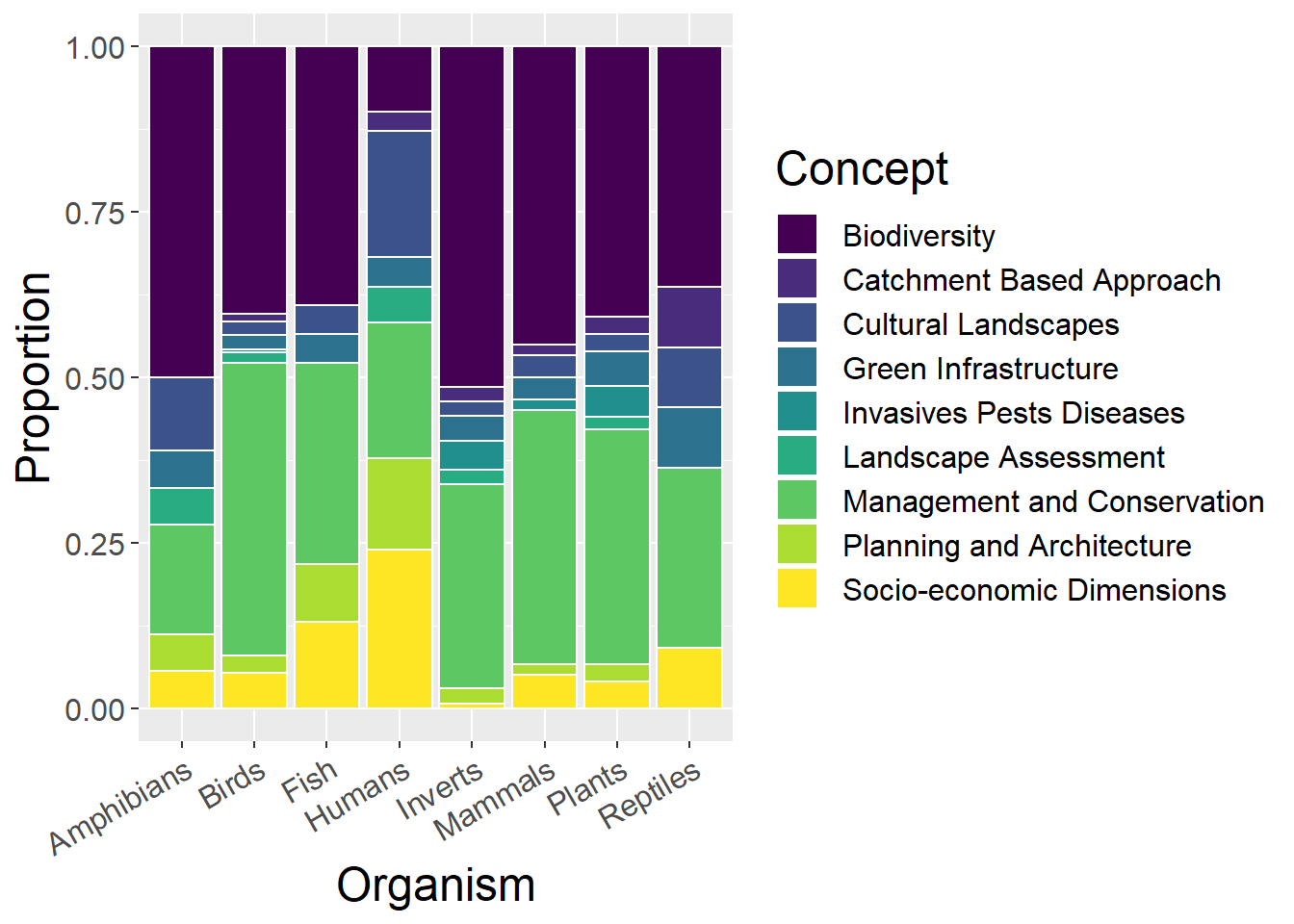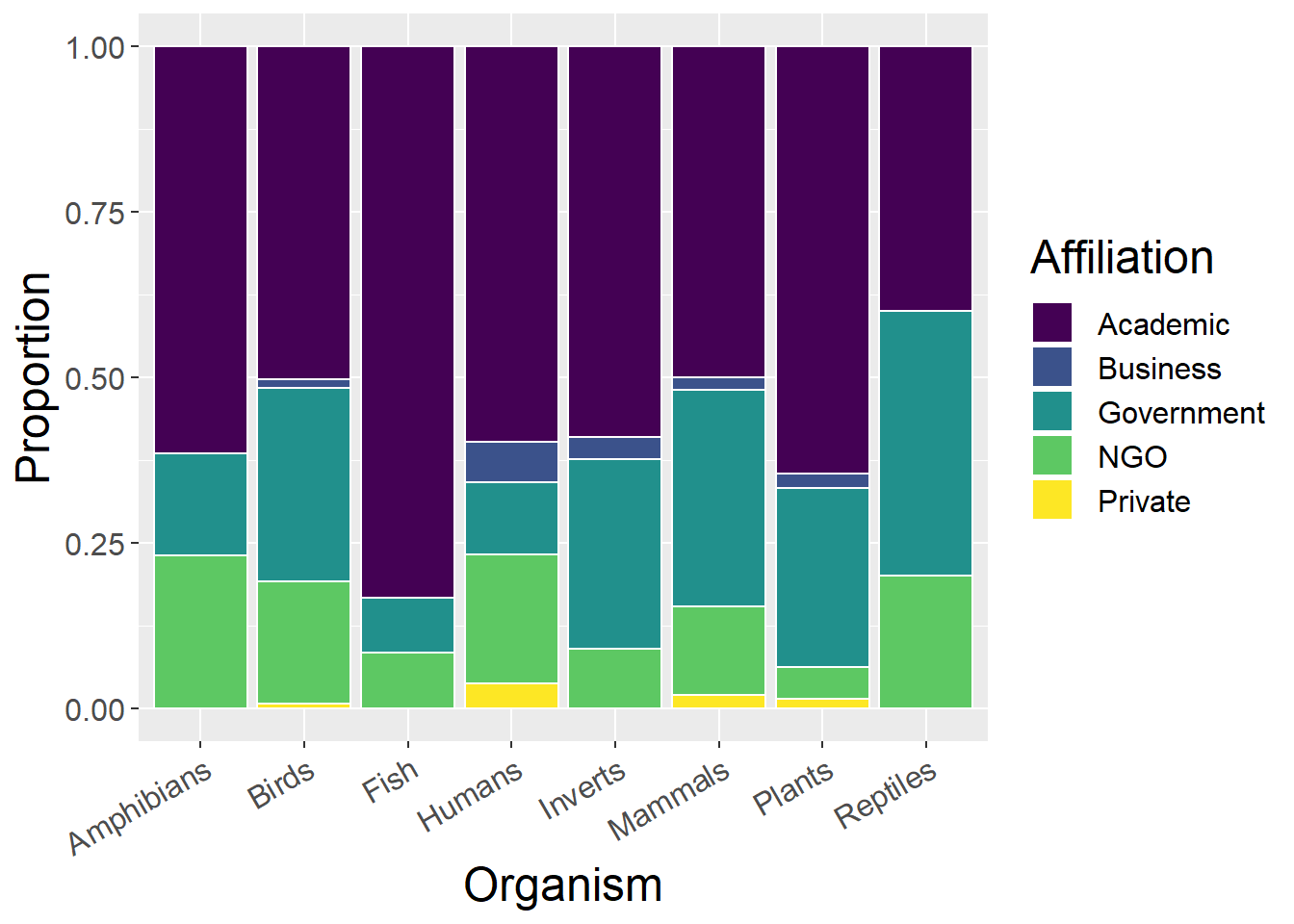Chapter 5 Analysis by Organism
Bar charts and tables to examine how contributions to conferences vary by organism
5.1 Total Conference Contributions
#spec(cpdata)
sppdata <- cpdata %>%
select_if(is.numeric) %>%
gather(key = SppType, value = count, Mammals:Fish) %>%
filter(count > 0) %>%
group_by(`SppType`) %>%
summarise_all(sum, na.rm=T) General observations:
- Amphibians, Fish, Reptiles are little studied
sppdata %>%
select(SppType, count) %>%
mutate(prop = count/sum(count)) %>%
mutate(prop = round(prop,3)) %>%
kable() %>%
kable_styling() %>%
scroll_box(width = "100%")| SppType | count | prop |
|---|---|---|
| Amphibians | 11 | 0.022 |
| Birds | 128 | 0.256 |
| Fish | 11 | 0.022 |
| Humans | 79 | 0.158 |
| Inverts | 104 | 0.208 |
| Mammals | 43 | 0.086 |
| Plants | 119 | 0.238 |
| Reptiles | 5 | 0.010 |
ggplot(sppdata, aes(x=SppType, y=count)) +
geom_bar(stat="identity") +
geom_text(aes(x=SppType, y=max(count), label = paste0(round(100*count / sum(count),1), "%"), vjust=-0.25)) +
labs(y = "Abstract Count", x="Organism")
5.3 Landscape Type
5.3.1 Using all landscape types
General observations:
- Human studies are most evenly distributed across landscape types
- Unsurprisingly, fish are studies in riverscapes and seascapes
- Birds, plants and inverts studies dominated by Lowland rural studies
lspCounts <- sppdata %>%
select(SppType,`Upland rural`, `Lowland rural`, Urban, Riverscape, Seascape, `Undefined LspType`,Other) %>%
mutate(sum = rowSums(.[2:8])) %>% #calculate total for subsquent calcultation of proportion
gather(key = Type, value = count, -SppType, -sum) %>%
mutate(prop = count / sum) #calculate proportion
ggplot(lspCounts, aes(x=SppType, y=count, fill=Type)) + geom_bar(stat="identity", colour="white") +
scale_fill_viridis(discrete = TRUE) +
theme(axis.text.x = element_text(angle = 30, hjust = 1)) +
labs(fill="Landscape Type", y = "Abstract Count", x="Organism")
ggplot(lspCounts, aes(x=SppType, y=prop, fill=Type)) + geom_bar(stat="identity", colour="white") +
scale_fill_viridis(discrete = TRUE) +
theme(axis.text.x = element_text(angle = 30, hjust = 1)) +
labs(fill="Landscape Type", y = "Proportion", x="Organism")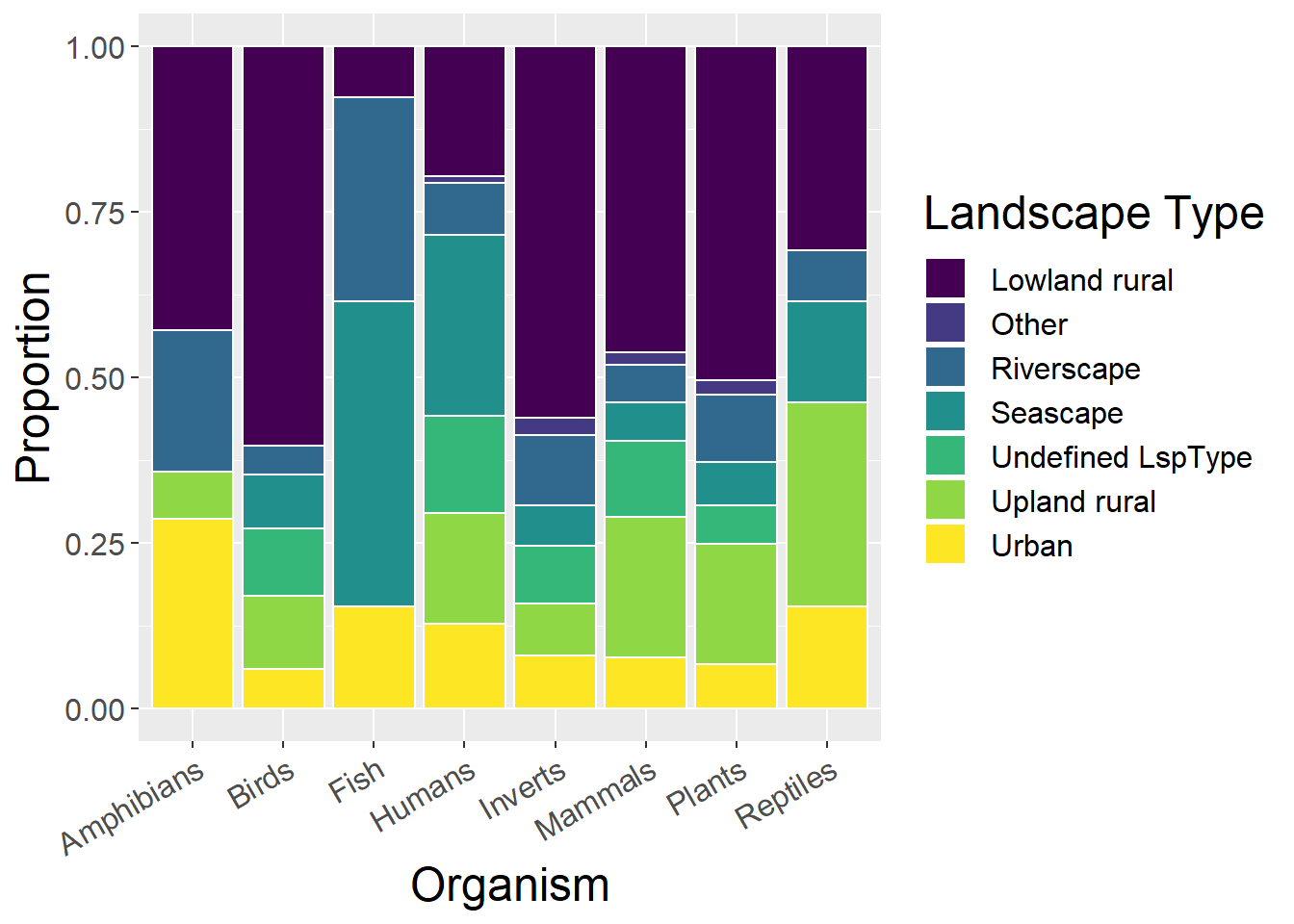
5.3.2 Without ‘Undefined LspType’ and ‘Other’ landscape types
General observations:
- Birds, Plants and Mammals studies predominantly in Lowland Rural lsps
- Plants studies are greatest contribution (in total number) to Upland Rural lsps
lspCounts <- sppdata %>%
select(SppType,`Upland rural`, `Lowland rural`, Urban, Riverscape, Seascape) %>%
mutate(sum = rowSums(.[2:6])) %>% #calculate total for subsquent calcultation of proportion
gather(key = Type, value = count, -SppType, -sum) %>%
mutate(prop = count / sum) #calculate proportion
ggplot(lspCounts, aes(x=SppType, y=count, fill=Type)) + geom_bar(stat="identity", colour="white") +
scale_fill_viridis(discrete = TRUE) +
theme(axis.text.x = element_text(angle = 30, hjust = 1)) +
labs(fill="Landscape Type", y = "Abstract Count", x="Organism")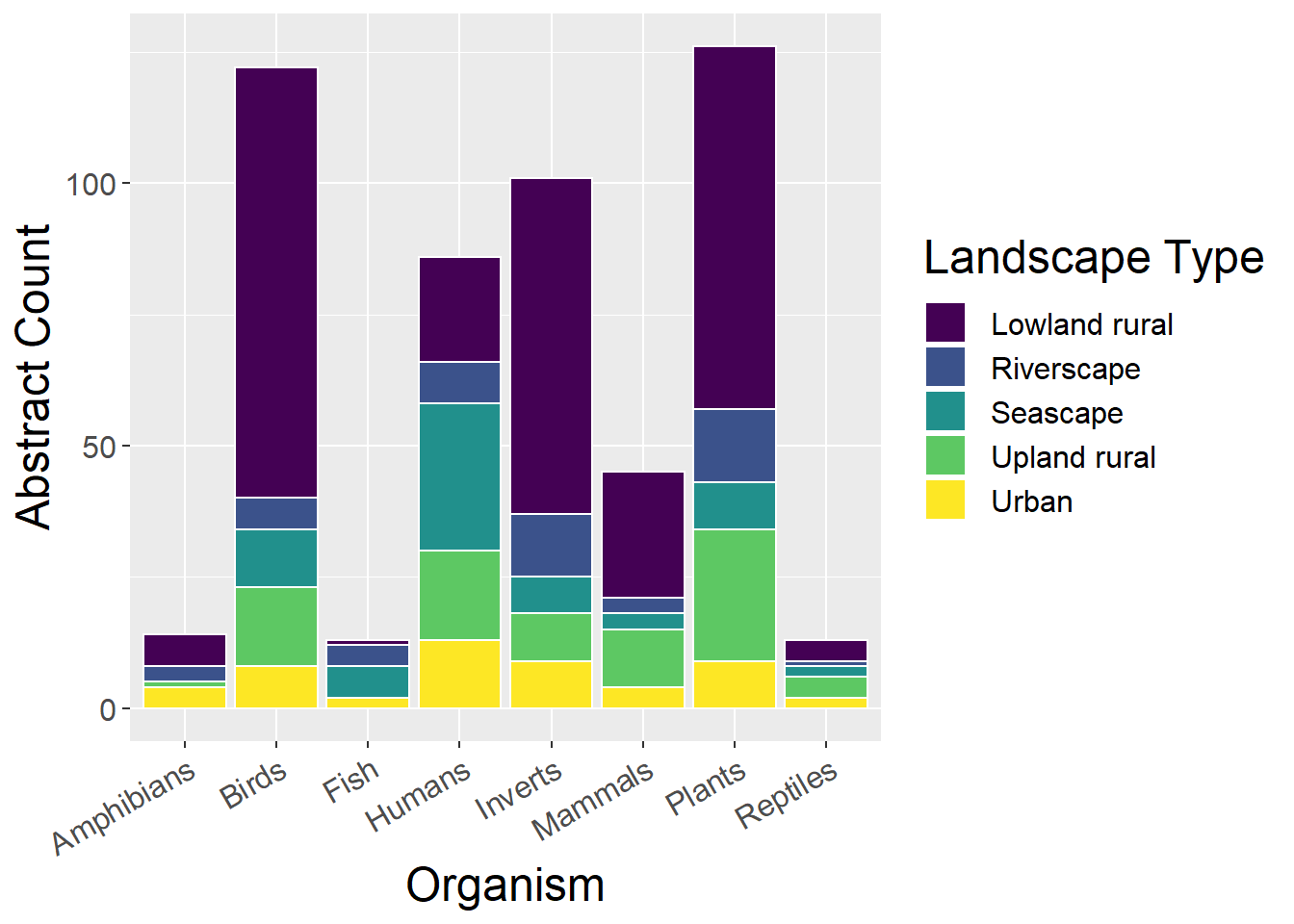
ggplot(lspCounts, aes(x=SppType, y=prop, fill=Type)) + geom_bar(stat="identity", colour="white") +
scale_fill_viridis(discrete = TRUE) +
theme(axis.text.x = element_text(angle = 30, hjust = 1)) +
labs(fill="Landscape Type", y = "Proportion", x="Organism")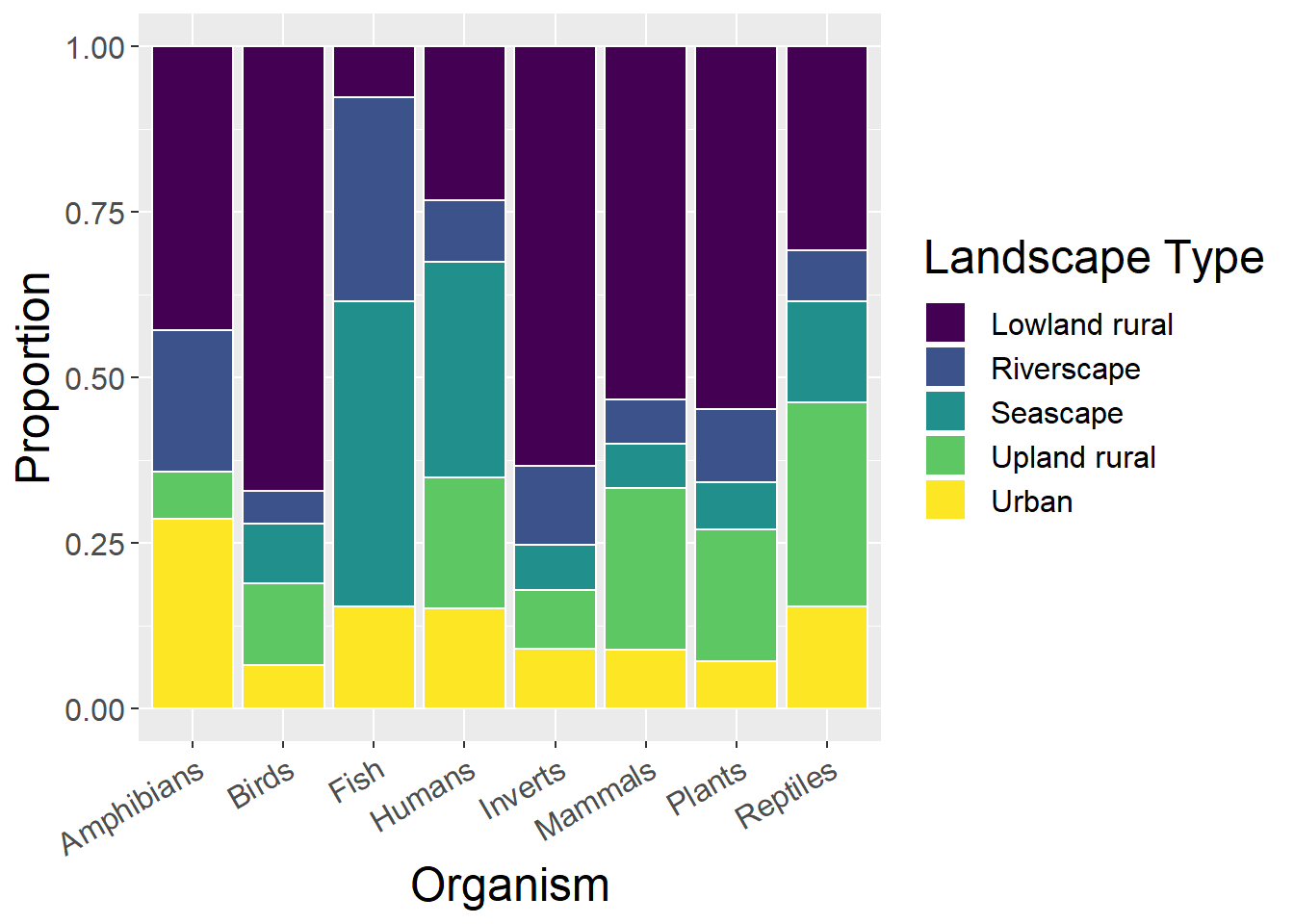
5.4 Methods
General observations:
- Humans dominated by qualitative studies, with few empirical (i.e. few interviews, questionnaires?)
- Possibly surprisingly, plants do not have many RS studies
methodsCounts <- sppdata %>%
select(SppType, Empirical, Theoretical, Qualitative, Quantitative, GIS, `Remote sensing`) %>%
mutate(sum = rowSums(.[2:7])) %>%
gather(key = Type, value = count, -SppType, -sum) %>%
mutate(prop = count / sum)
ggplot(methodsCounts, aes(x=SppType, y=count, fill=Type)) + geom_bar(stat="identity", colour="white") +
scale_fill_viridis(discrete = TRUE) +
theme(axis.text.x = element_text(angle = 30, hjust = 1)) +
labs(fill="Method", y = "Abstract Count", x="Organism")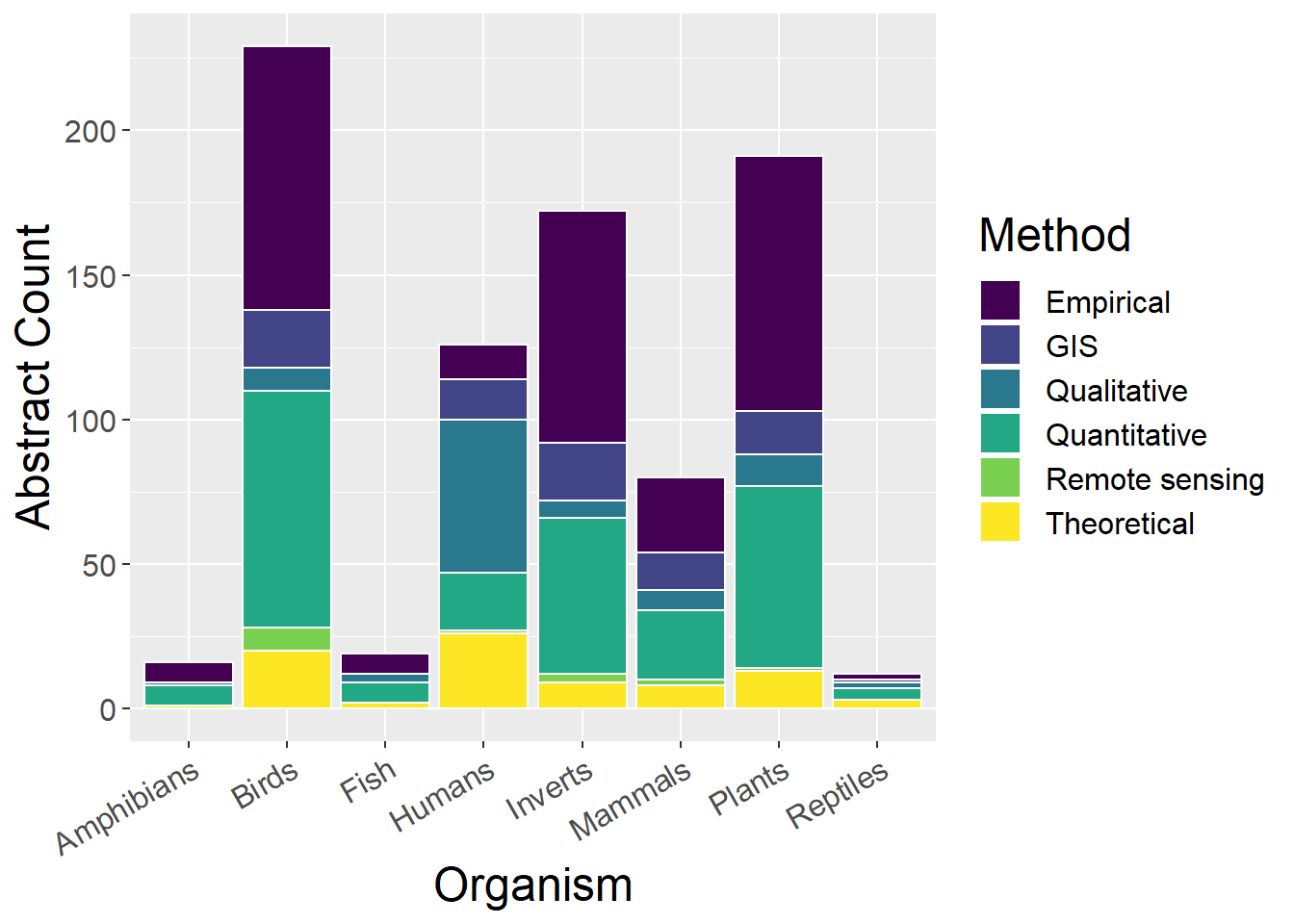
ggplot(methodsCounts, aes(x=SppType, y=prop, fill=Type)) + geom_bar(stat="identity", colour="white") +
scale_fill_viridis(discrete = TRUE) +
theme(axis.text.x = element_text(angle = 30, hjust = 1)) +
labs(fill="Method", y = "Proportion", x="Organism")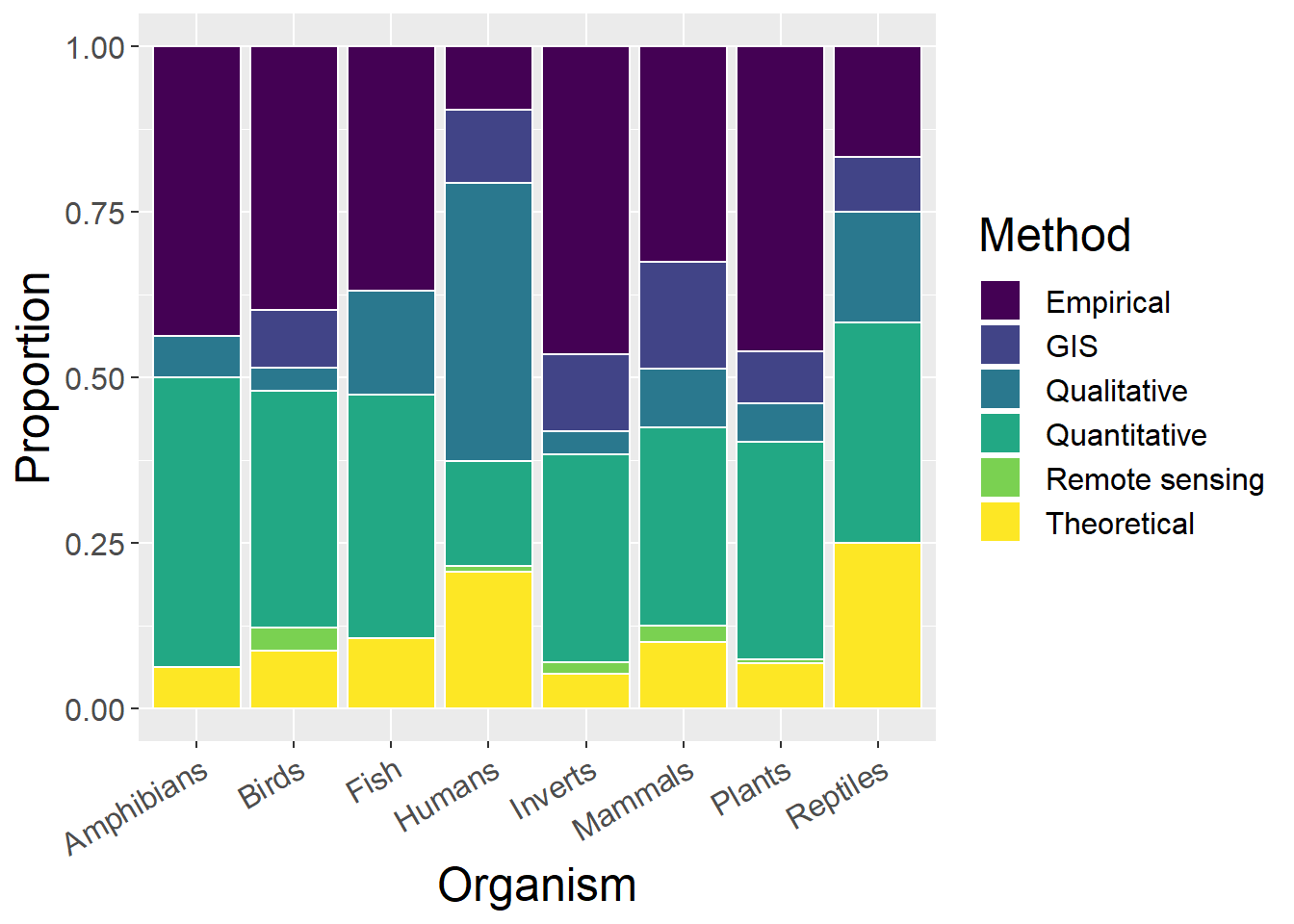
5.5 Spatial Extent
General observations:
- Inverts dominated by mini studies
- Fish have relatively high proportion of Global studies
- Other species have reasonably evenly distributed proportions of scales
spatialCounts <- sppdata %>%
select(SppType, Micro, Mini, Local, Regional, National, Continental, Global,`Undefined Extent`) %>%
mutate(sum = rowSums(.[2:9])) %>%
gather(key = Type, value = count, -SppType, -sum) %>%
mutate(prop = count / sum)
factor_order <- c('Micro', 'Mini', 'Local', 'Regional', 'National', 'Continental', 'Global','Undefined Extent')
factor_labels <- c('Micro', 'Mini', 'Local', 'Regional', 'National', 'Continental', 'Global','Undefined')
ggplot(spatialCounts, aes(x=SppType, y=count, fill=factor(Type, level=factor_order))) + geom_bar(stat="identity", colour="white") +
scale_fill_viridis(discrete = TRUE) +
theme(axis.text.x = element_text(angle = 30, hjust = 1)) +
labs(fill="Extent", y = "Abstract Count", x="Organism")
ggplot(spatialCounts, aes(x=SppType, y=prop, fill=factor(Type, level=factor_order))) + geom_bar(stat="identity", colour="white") +
scale_fill_viridis(discrete = TRUE) +
theme(axis.text.x = element_text(angle = 30, hjust = 1)) +
labs(fill="Extent", y = "Proportion", x="Organism")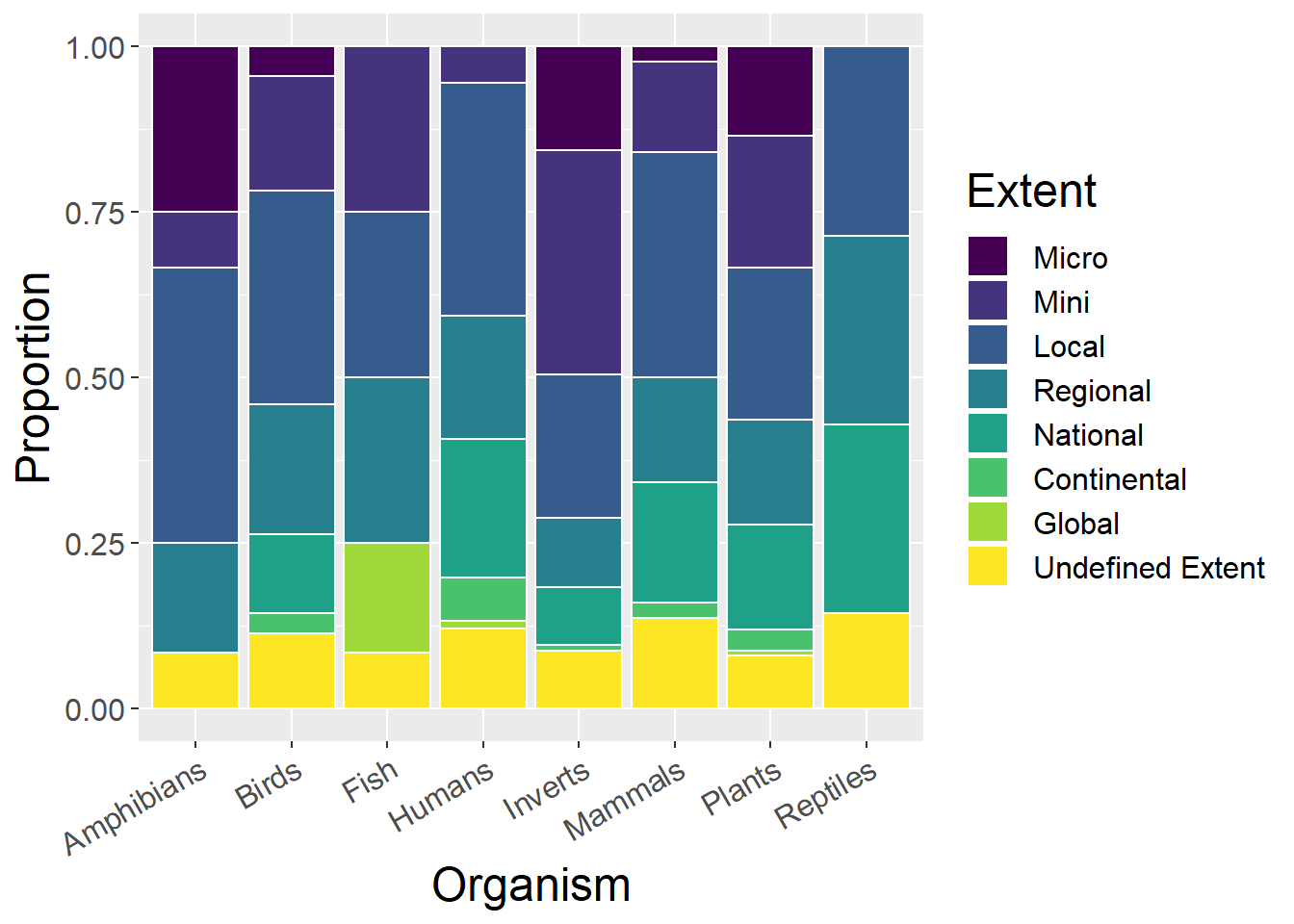
5.6 Temporal Extent
5.6.1 With undefined
General observations:
- Difficult to see much; examine without ‘undefined’

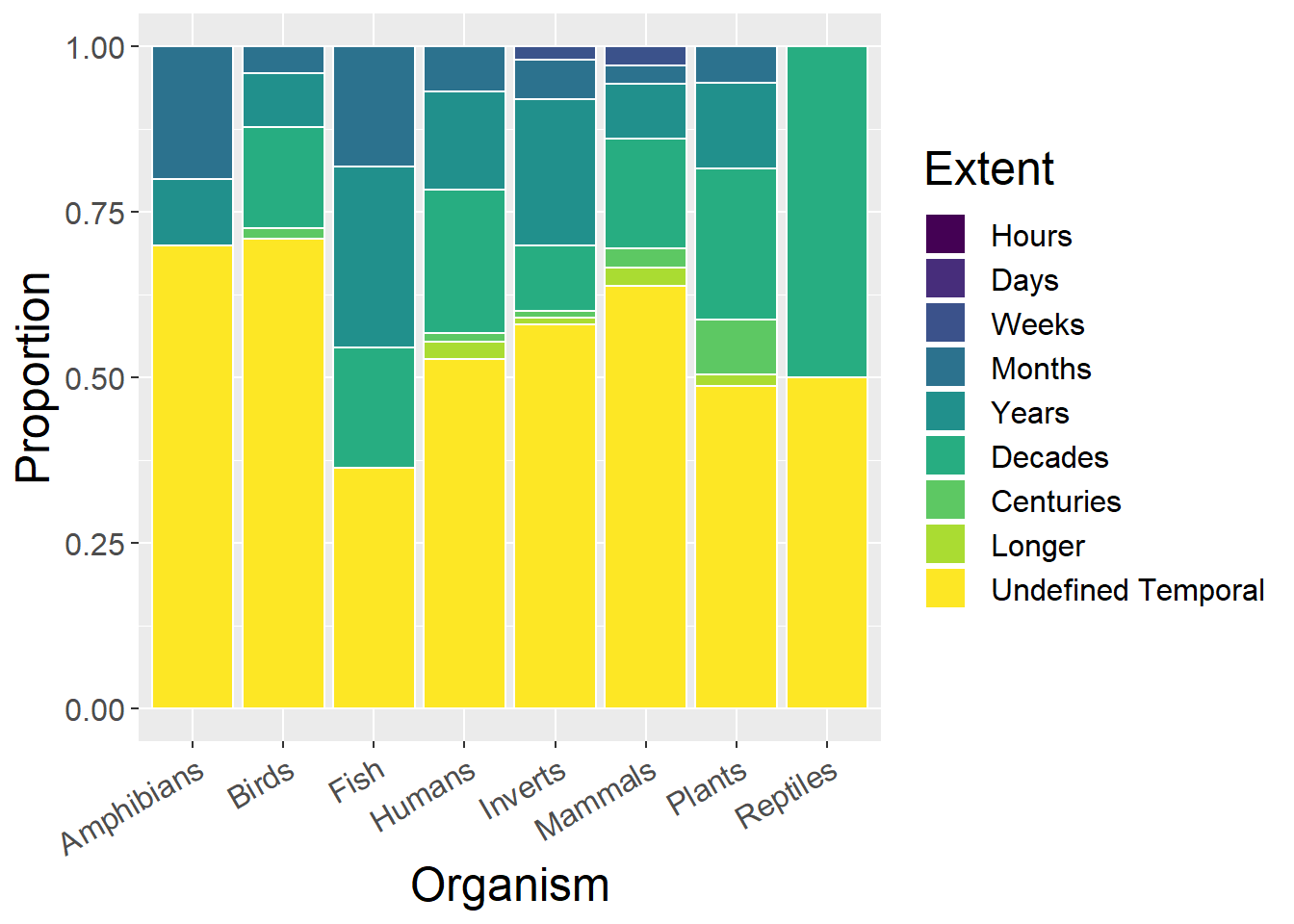
5.6.2 Without Undefined
General observations:
- Inverts dominated by annual (Yearly) studies, plus shorter studies
- Plants have greatest proportions of longer studies (Decadal and Centuries) - makes sense given rates of change?
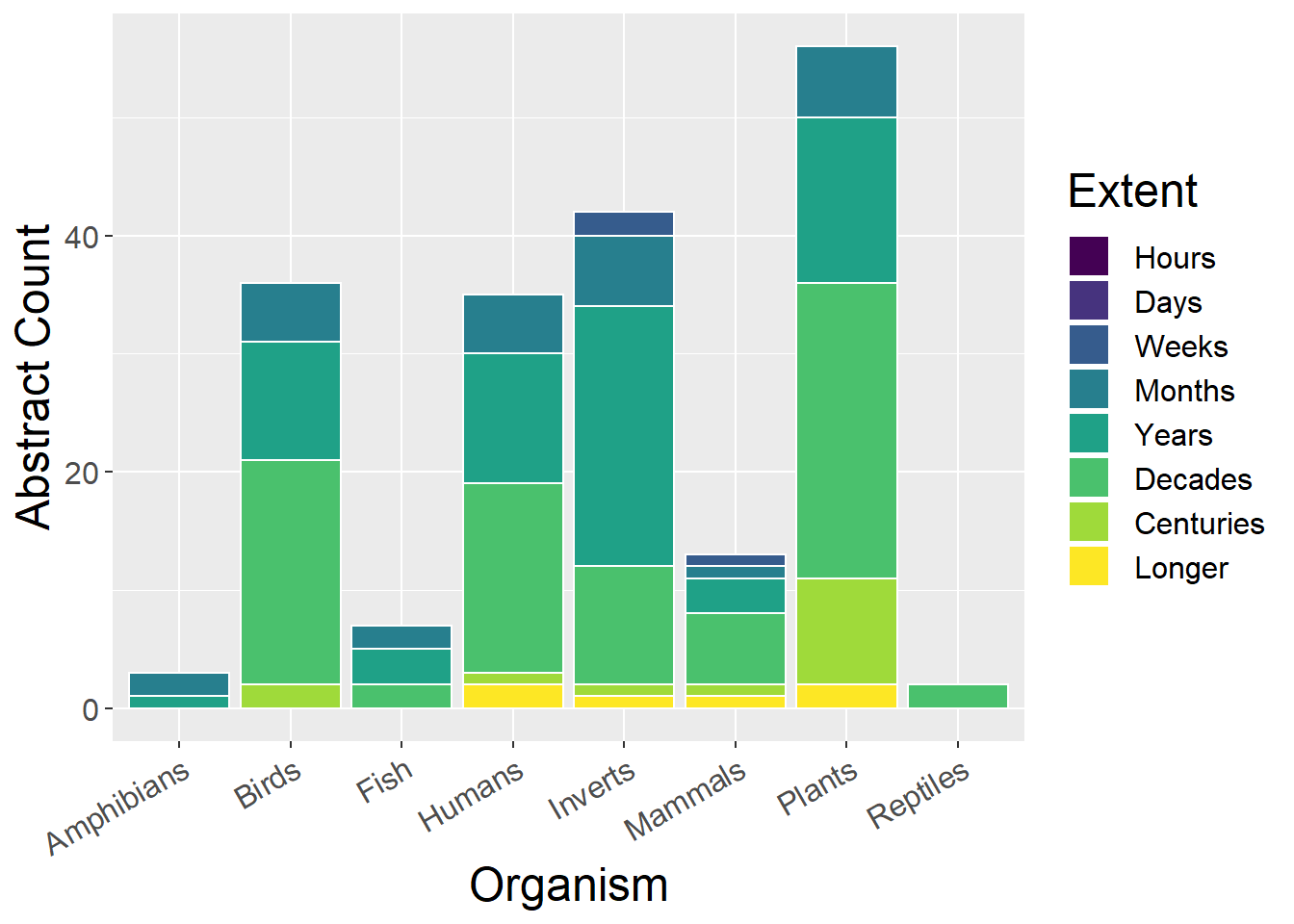
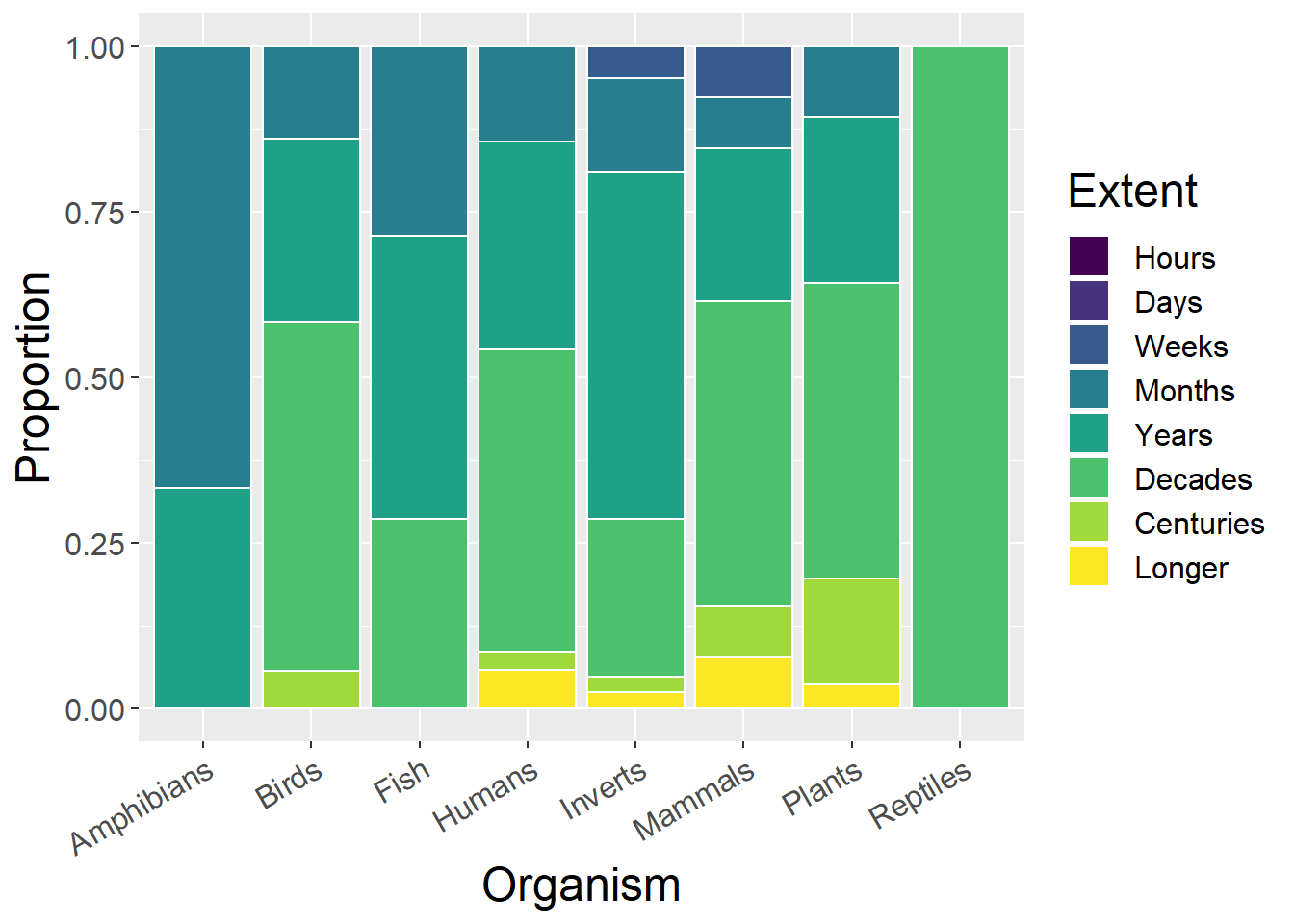
5.7 Concepts
General observations:
- Humans have a relatively large proportion of Ecosystem Services studies (not surprising?)
- Plants have largest number of LUCC studies
conceptCounts <- sppdata %>%
select(SppType, `PPS of landscapes`,
`Connectivity and fragmentation`, `Scale and scaling`,`Spatial analysis and modeling`,LUCC,`History and legacy`,`Climate change interactions`,`Ecosystem services`,`Landscape sustainability`,`Accuracy and uncertainty`
) %>%
mutate(sum = rowSums(.[2:11])) %>%
gather(key = Type, value = count, -SppType, -sum) %>%
mutate(prop = count / sum)
ggplot(conceptCounts, aes(x=SppType, y=count, fill=Type)) +
geom_bar(stat="identity", colour="white") +
scale_fill_viridis(discrete = TRUE) +
theme(axis.text.x = element_text(angle = 30, hjust = 1)) +
labs(fill="Concept", y = "Abstract Count", x="Organism")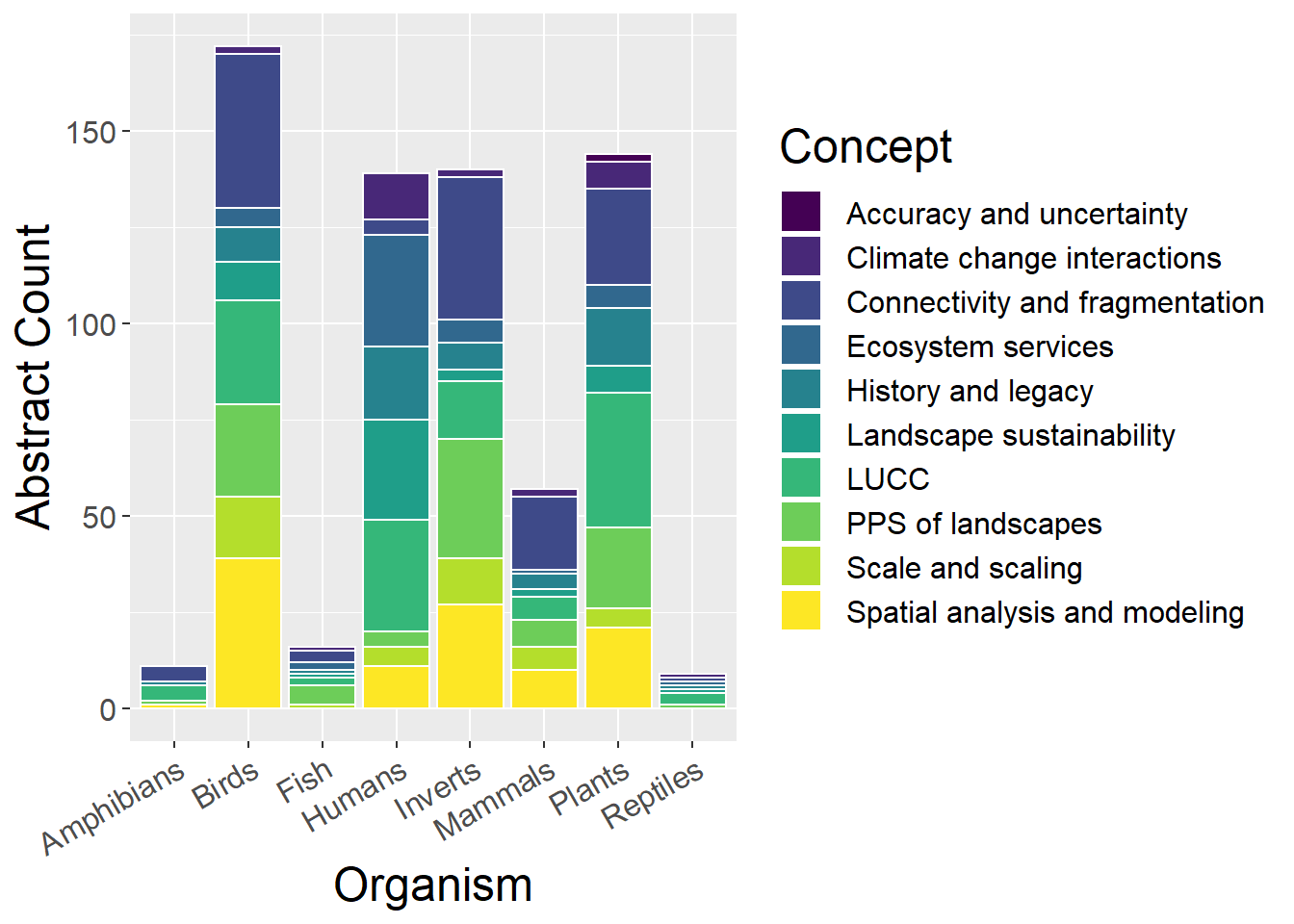
ggplot(conceptCounts, aes(x=SppType, y=prop, fill=Type)) +
geom_bar(stat="identity", colour="white") +
scale_fill_viridis(discrete = TRUE) +
theme(axis.text.x = element_text(angle = 30, hjust = 1)) +
labs(fill="Concept", y = "Proportion", x="Organism")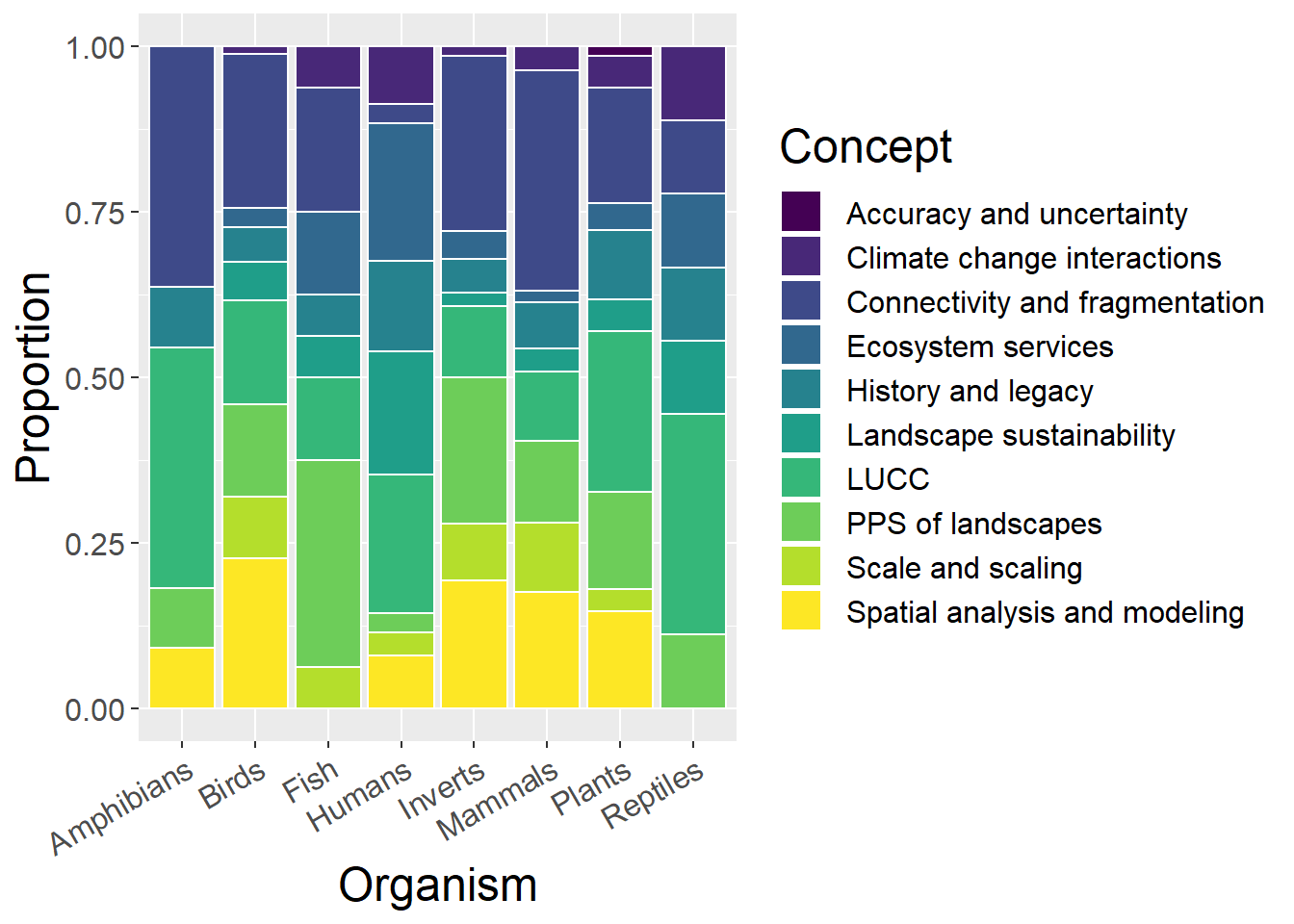
5.8 Other Concepts
General observations:
- Humans have largest proportion of Cultural Landscapes, Socio-Economic and Planning studies (unsurprising?)
- Birds, Inverts and Mammals dominates by biodiveristy and Management and Conservation studies
othCCounts <- sppdata %>%
select(SppType, `Green Infrastructure`,`Planning and Architecture`,`Management and Conservation`,`Cultural Landscapes`,`Socio-economic Dimensions`,Biodiversity,`Landscape Assessment`,`Catchment Based Approach`,`Invasives Pests Diseases`
) %>%
mutate(sum = rowSums(.[2:10])) %>%
gather(key = Type, value = count, -SppType, -sum) %>%
mutate(prop = count / sum)
ggplot(othCCounts, aes(x=SppType, y=count, fill=Type)) + geom_bar(stat="identity", colour="white") +
scale_fill_viridis(discrete = TRUE) +
theme(axis.text.x = element_text(angle = 30, hjust = 1)) +
labs(fill="Concept", y = "Abstract Count", x="Organism")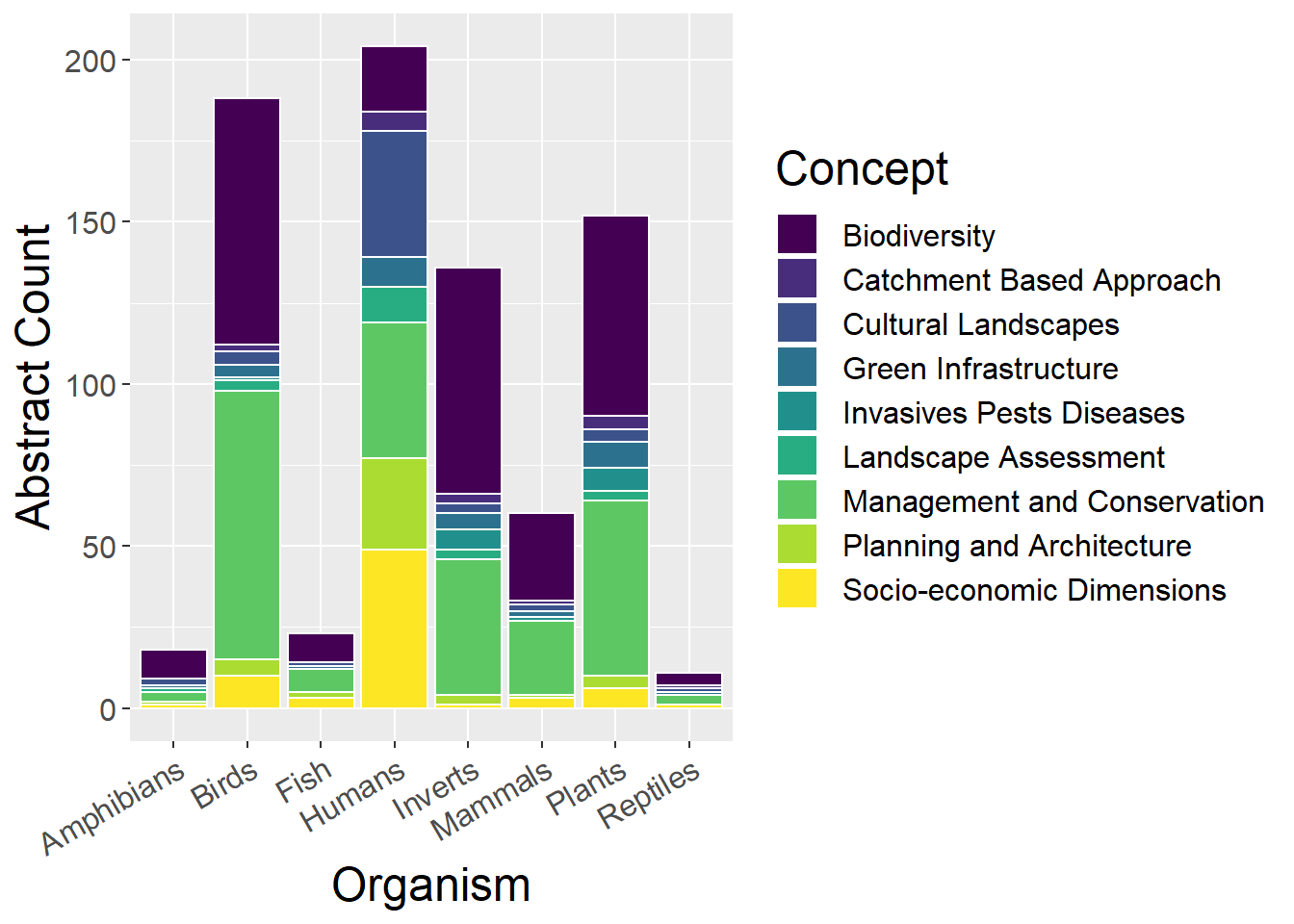
ggplot(othCCounts, aes(x=SppType, y=prop, fill=Type)) + geom_bar(stat="identity", colour="white") +
scale_fill_viridis(discrete = TRUE) +
theme(axis.text.x = element_text(angle = 30, hjust = 1)) +
labs(fill="Concept", y = "Proportion", x="Organism")